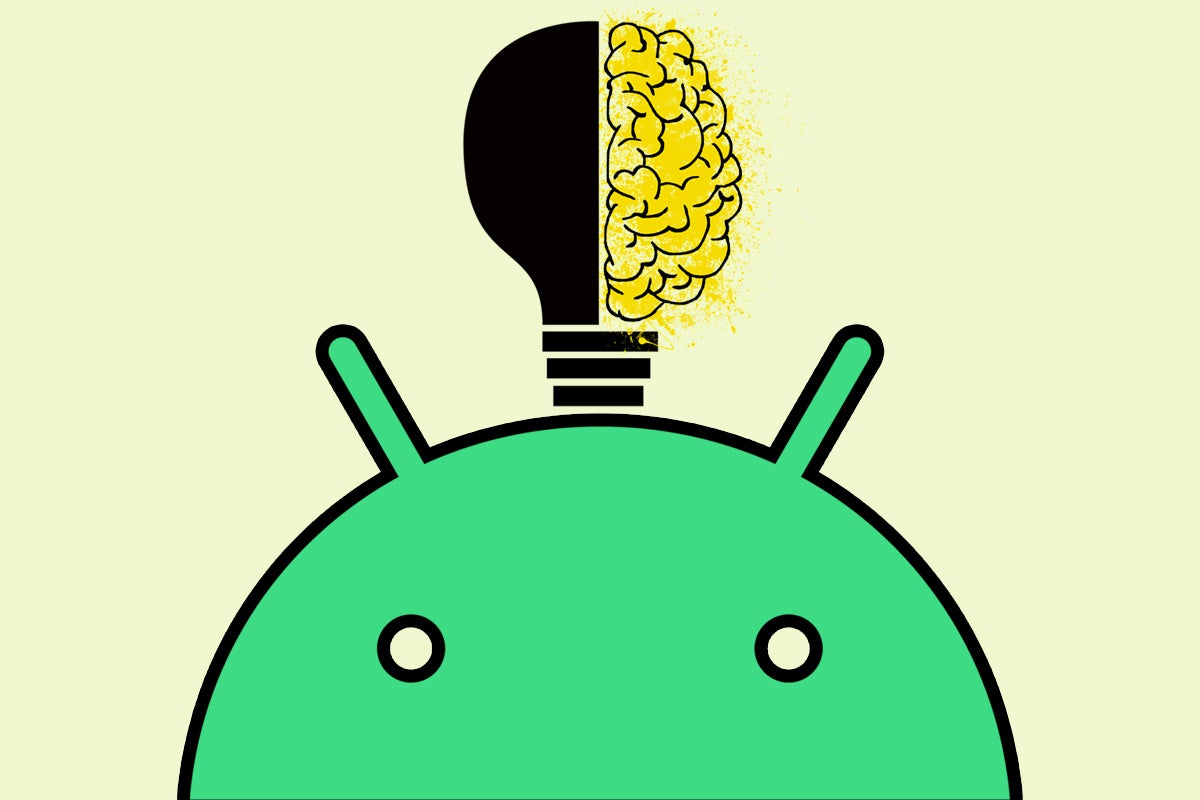With every new Android version comes a flurry of fancy fresh features. Some of them immediately transform the way we work, while others just quietly fade away without making much noise.
And then there are the features that fall somewhere in between — features that seem useful, maybe even pique our interest when we first hear about ’em, but then get lost in the shuffle and forgotten as time wears on. Especially when said features are out of sight and not at all obvious, they’re all too easy to overlook and abandon.
Well, as we look ahead to the launch of yet another new Android version — Android 12, expected to be announced any moment now (and already leaking out like crazy) — consider this your friendly reminder: These hidden Android features, added into the operating system at various points over the past several years, are still there and still incredibly handy. Take a moment to rediscover ’em and remind yourself what you’ve been missing.
Hidden Android feature #1: Fast app-switching
One of the most useful features to come into Android in ages is also one of the least well-known and discoverable. I’m talkin’ about the Alt-Tab-like fast app-switching function that was first introduced way back in 2016’s Android 7 and remains one of my favorite Android shortcuts to this day (along with, of course, all those awesome Gboard shortcuts we talked about last week!).
You can be forgiven if you forgot about it — or maybe never even knew about it in the first place — because, honestly, there’s absolutely nothing that’d clue you into its existence. And it’s evolved a fair amount over the years, too, which makes the odds of losing track of it even greater.
So here’s how it works: First, if you’re using Android’s current gesture system — with no on-screen navigation buttons and just a thin little line at the bottom of your screen — flick your finger toward the right anywhere along that bottom-of-screen area. That’ll snap you back to your most recently used app faster than you can say “frugal Google bugle filled with tasty kugel” (which, to be fair, isn’t something you can say especially fast). From there, you can click flick again toward the right to go back another step in your app-using history or flick to the left to snap back in the other direction.
You can also do less of a flick and more of an arching swipe — moving your finger upward, ever so slightly, as you slide toward the left or the right on the bottom of the screen — if you want to get a better look at the apps in the list before making the switch.
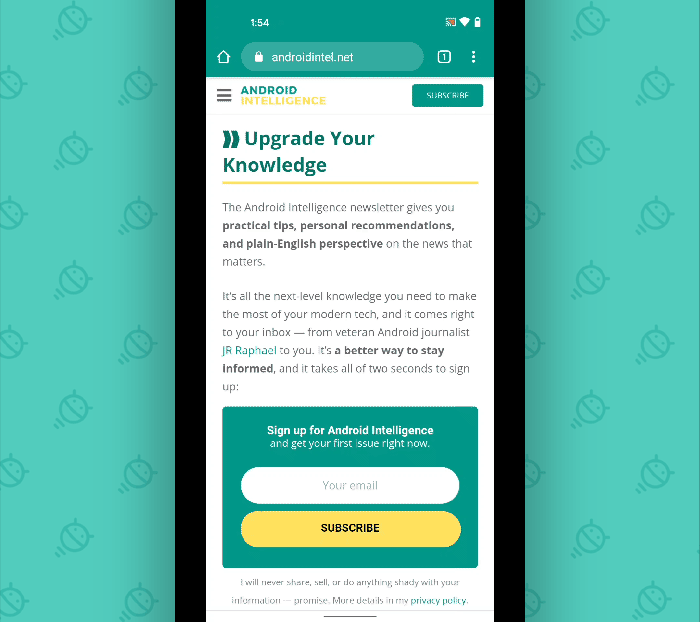 JR
JR The farther you swipe and the higher you go, the more apps you’ll see — all in the order of when you last used ’em.
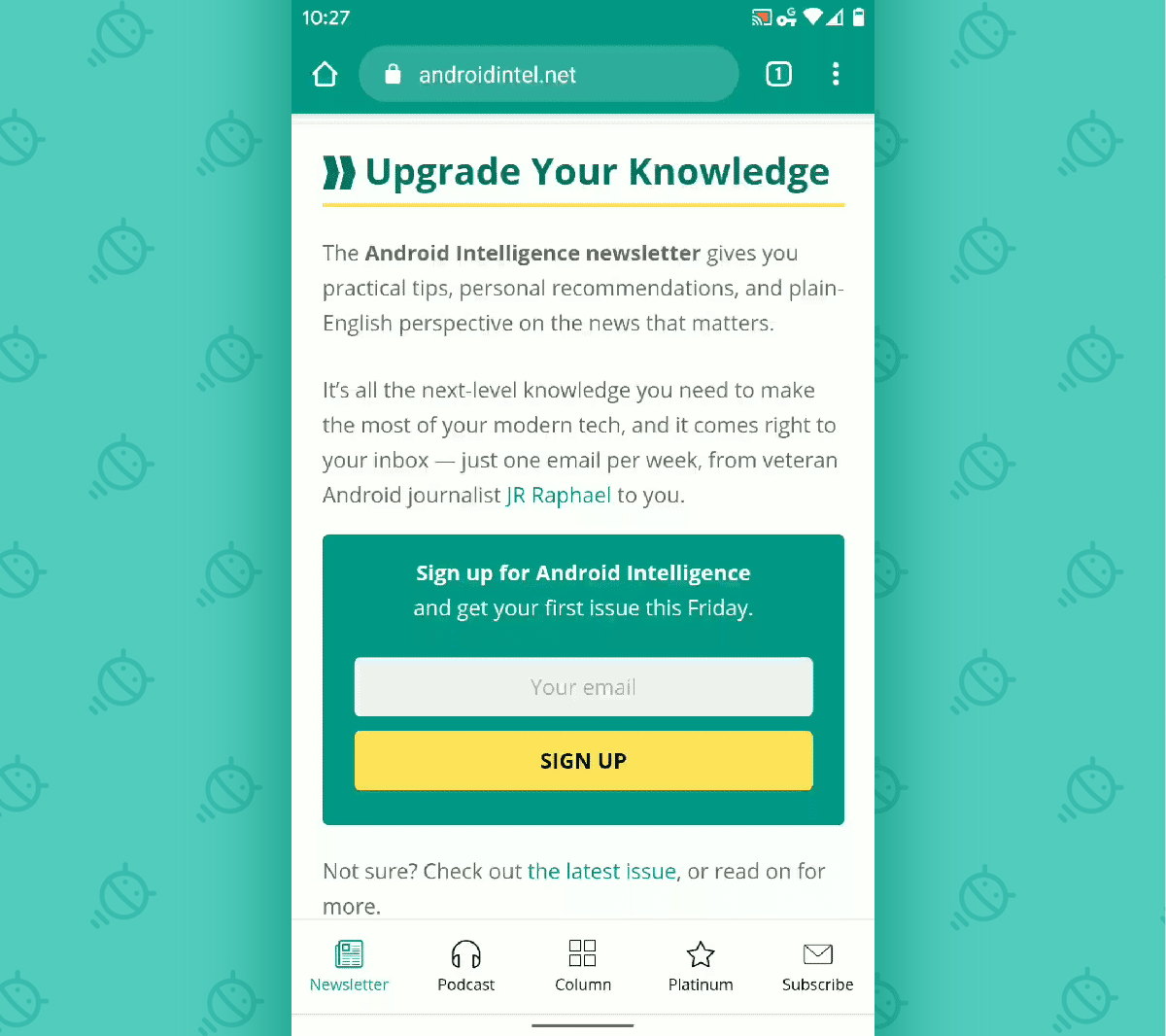 JR
JR If you’re still using Android’s older three-button navigation system, fear not, for you can do this, too — part of it, anyway: Just double-tap the Overview key (the square-shaped icon next to Back and Home) anytime to quickly zap between your two most recently used processes.
Hidden Android feature #2: App shortcuts
Speaking of app-related shortcuts, Android has an incredibly handy system called — rather fittingly — App Shortcuts. They’re completely hidden out of sight, though, and they’re consequently all too easy to ignore on accident.
But Goog almighty, can they ever be useful. You can think of App Shortcuts as direct links to specific functions within apps on your phone — ways you can get to individual actions or areas within an app without having to go through the typical process of opening it up, hunting around through its menus, and tapping multiple commands to get where you want to go.
To look through your App Shortcut options, press and hold your finger down on any app’s icon — either on your home screen or in your app drawer — for about a second. The options vary from one app to the next, but you’re bound to find some fantastic treasures. For instance:
- With Google’s Messages app, long-pressing the app’s icon lets you jump directly into a variety of recently used message threads.
- With Google Docs, you can hop straight into a new document or to the service’s search function without having to first open the app and poke around.
- With Google Drive, you can get direct links for searching, uploading a new file, or even scanning a physical document with your phone’s camera.
- And with Google Calendar, you can create a new event, a new task, or a new Assistant-linked reminder right from that hidden long-press menu.
The list goes on from there, so take the time to tap around and explore what the apps you use have to offer. And when you find a shortcut that seems especially useful for the way you work, remember this extra invisible trick: You can pull any shortcut out of an app’s long-press menu and put it directly on your home screen for even easier one-tap access. Just press and hold the shortcut you want and then drag it into any open space on your home screen.
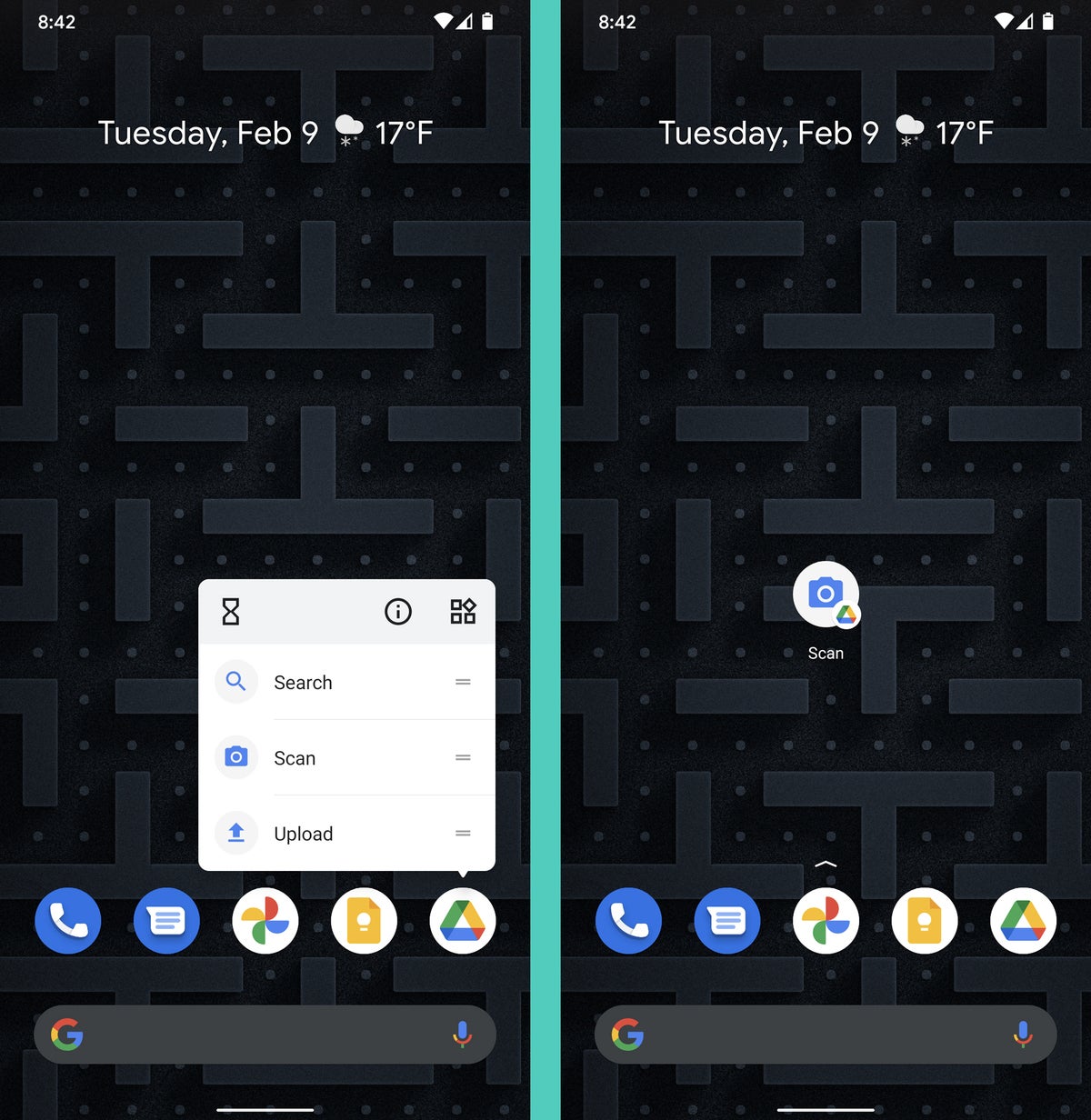 JR
JR Who knew?!
Hidden Android feature #3: Live Caption
Google’s Android 10 release introduced an unexpected gem into the operating system — something that has the potential to be way more useful than you’d expect at first glance. It’s called Live Caption, and it’s technically an accessibility feature for folks who have a hard time hearing.
The benefit in that scenario is obvious, but Live Caption can also come in handy for practically anyone on a day-to-day basis — because what it effectively does is allow you to see what a video or podcast is saying without having to have any audible sound playing from your device. I’ll often flip it on briefly when I want to “listen in” to some manner of multimedia while I don’t have headphones handy and am in a situation where blaring sound out from my phone’s speakers wouldn’t exactly be optimal.
In such moments, all I’ve gotta do is tap a little box that shows up beneath the volume controls whenever any kind of media is playing on my device — and holy moly, wouldya look at that?
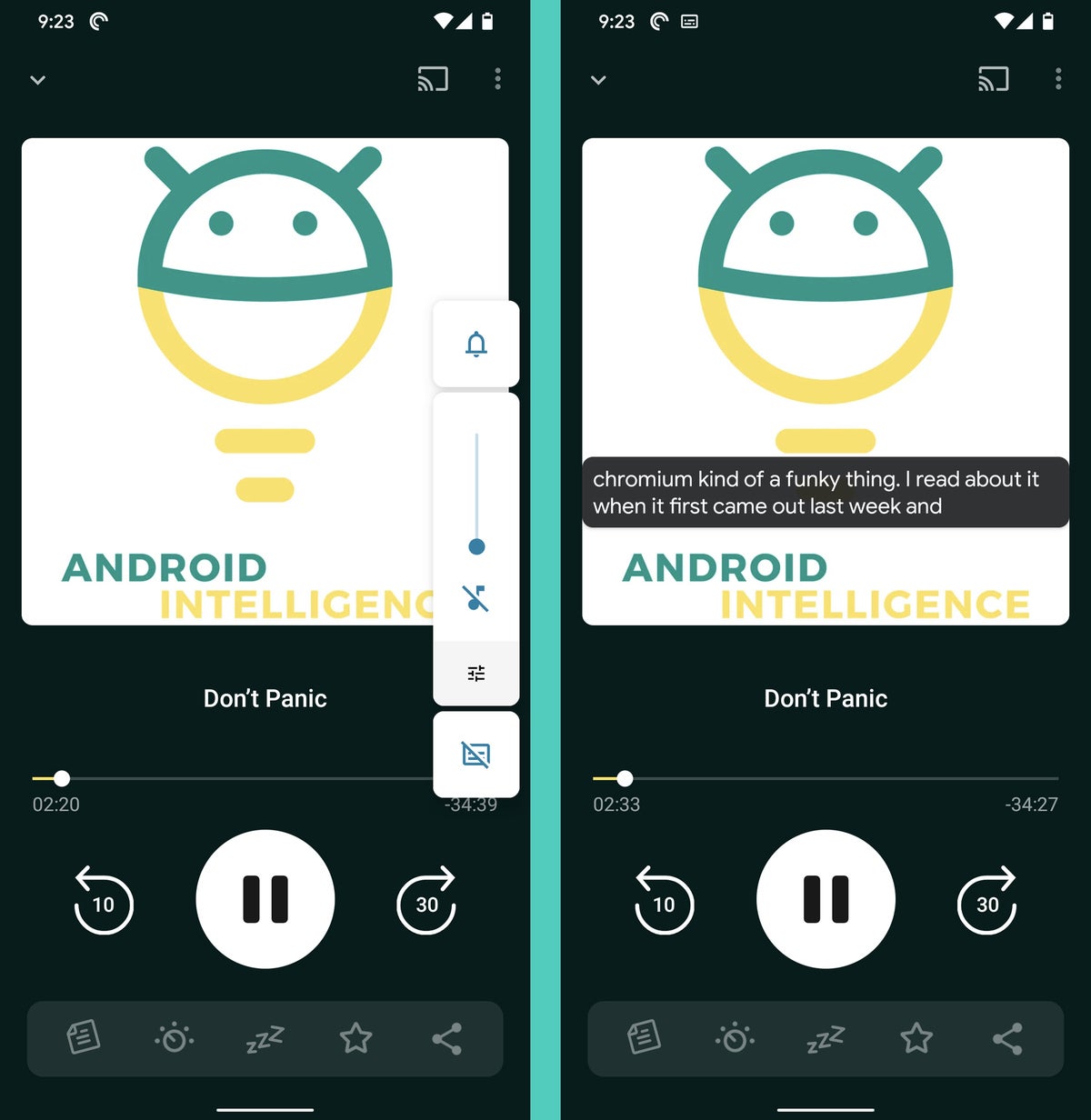 JR
JR Just like magic, every word being uttered in the video or audio clip shows up on my screen so I can read it whilst having the actual sound turned all the way down.
And you know what? Let’s take this hidden-feature concept a step further, ’cause there are actually two more easy-to-miss possibilities within this system. Once you’ve got Live Caption activated and you’re seeing captions on your screen, you can double-tap the caption box to make it bigger — or press and hold your finger onto the box to move it around anywhere on your screen. Whee!
If you’re using a phone with Android 10 or higher and you aren’t seeing that Live Caption option as part of your volume controls, head into your system settings and search for Live Caption there. You’ll probably need to find the associated section and flip a toggle into the on position within it to activate the feature — and, depending on your device (hi, Samsung folk!), you might also have to activate a second toggle in that same area to make sure the Live Caption option actually shows up as part of your volume panel.
On Samsung phones, you’ll also have to expand your volume panel (by tapping the little down-facing arrow within it) to find the Live Caption option — and the option will show up as a toggle instead of the simpler box icon that we’ve been talking about here.
No matter what type of phone you’re using, though, remember: The Live Caption option will only show up and work when some manner of sound is being played.
Hidden Android feature #4: Share menu pinning
This next tucked-away treat was first added into Android way back in the 2016 Nougat era but then taken away for a while and only brought back with last year’s Android 11 release. (Goodness gracious, Google, you’re making me dizzy.)
It’s the ability to customize the order of apps in your phone’s system-level Share menu — which means can then keep your own most frequently used sharing destinations at the top of the list for easy ongoing access. Yippee!
The feature is unfortunately complicated by the fact that lots of apps, including many of Google’s own utilities, now use custom share interfaces instead of relying on the system standard (grumble, grumble, grumble). But for any app that’s actually doing things in a sensible way and using the standard Android share menu, take note: So long as your phone is running Android 11, you can press and hold your finger to any item in that sharing list to pin it to the top. And it’ll then stay in that place for all future sharing, anytime the standard system menu is used.
To see for yourself, go highlight some text within an email in Gmail and select “Share” from the menu that comes up. Then press and hold that perfect little fingie of yours down onto any app you see in the list of sharing options — and, ta-da:
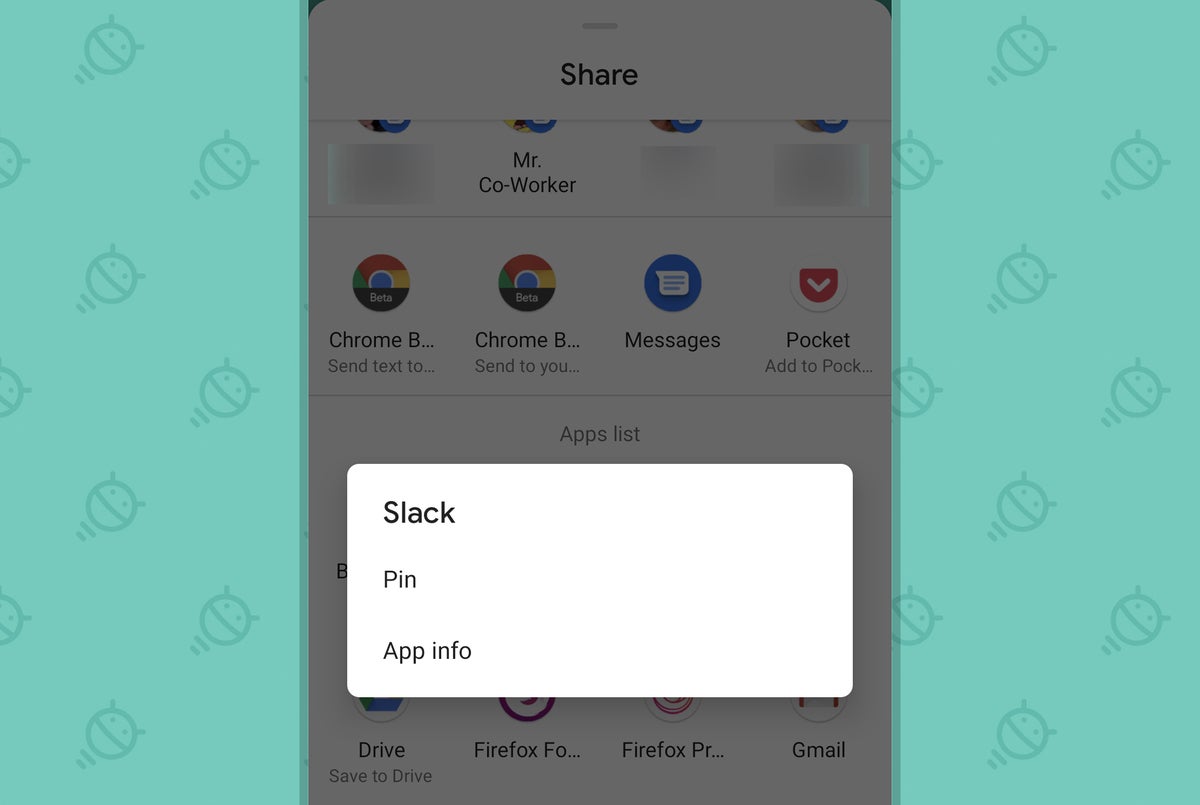 JR
JR You’ll see the command to pin it. You can pin up to four different sharing targets, if you want, and they’ll all appear in alphabetical order in a special row at the top of that menu.
Hidden Android feature #5: App pinning
An oft-overlooked feature introduced all the way back in 2014’s Android 5 release (mmm, Lollipop…) is a little somethin’ called app pinning. It lets you lock one specific app or process to your screen and then requires you to unlock your device before anything else can be accessed.
The idea is actually quite sensible: Say you’re passing your phone off to a friend, a co-worker, or some manner of rabid jungle bird — maybe so they can see a document, look at something on a website, or peck out a quick call while their own tiny bird-phone isn’t handy. Take two seconds to pin whatever app is relevant to that purpose to your screen, and you can rest easy knowing the rest of your stuff will remain secure and inaccessible until the phone’s back in your hands.
To use the feature, first search your system settings for App pinning — or, if you’re using a Samsung phone (where things are always arbitrarily renamed for no apparent reason), search instead for the far less logical Pin windows term.
However you get there, once you’re on the right settings screen, make sure the main toggle for the feature is activated — and make sure the toggle next to “Ask for unlock pattern before unpinning” (or “Use lock screen type to unpin,” with Samsung) is also in the on position.
Then just open up any app you want — and if you’re using Android’s gesture system, swipe up from the bottom of your screen to get to Android’s Overview interface. Tap the icon at the top of the card for your current app, and lookie what we have there: a snazzy new Pin option!
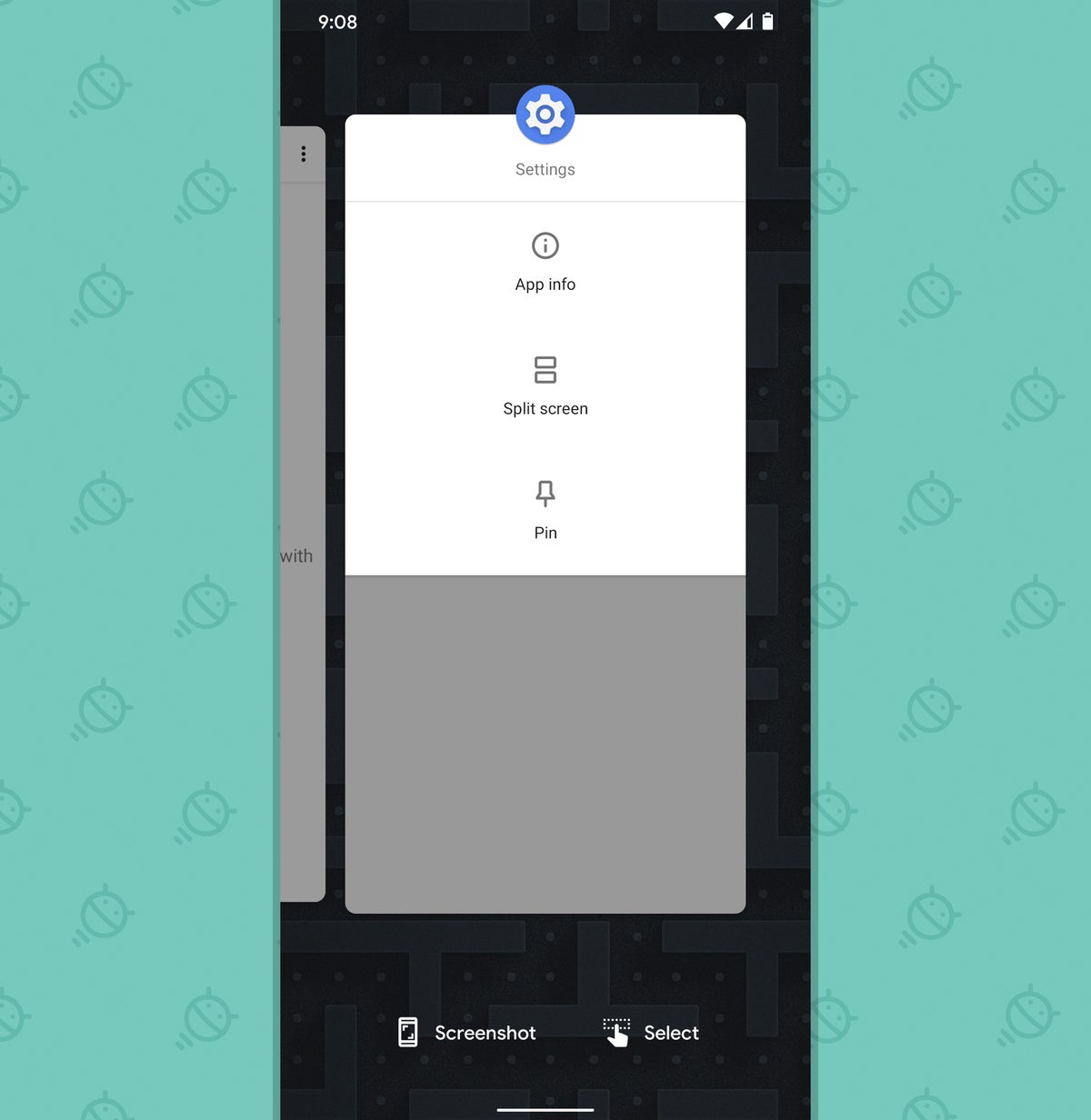 JR
JR Tap that bad boy, and tap it good. That app will then be locked in place, and to get to anything else, you’ll first have to swipe your finger up from the bottom of the screen and hold it in place for a few seconds — and then provide whatever manner of unlocking authentication (PIN, pattern, password, appendage, 14 drops of blood from your pinky toe, etc) is appropriate to continue.
If you’re still using Android’s old three-button nav system, you’ll instead press the square-shaped Overview button to get to the Overview interface, and you’ll press and hold the Back and Overview buttons together when you’re ready to unpin.
Hidden Android feature #6: Guest Mode
If you really want to keep your device protected from meddling while it’s in someone else’s hands and/or claws, take a minute to reacquaint yourself with Android’s clever and practical Guest Mode. It’s basically like an incognito mode for your entire phone: You just flip a switch, say “Wowser bowser, hubba bubba” for good measure, and then watch your phone shift itself into a blank-slate state — where your own personal apps, accounts, and data are all securely tucked away and you get an out-of-the-box-like experience, with only the basic preinstalled system apps available.
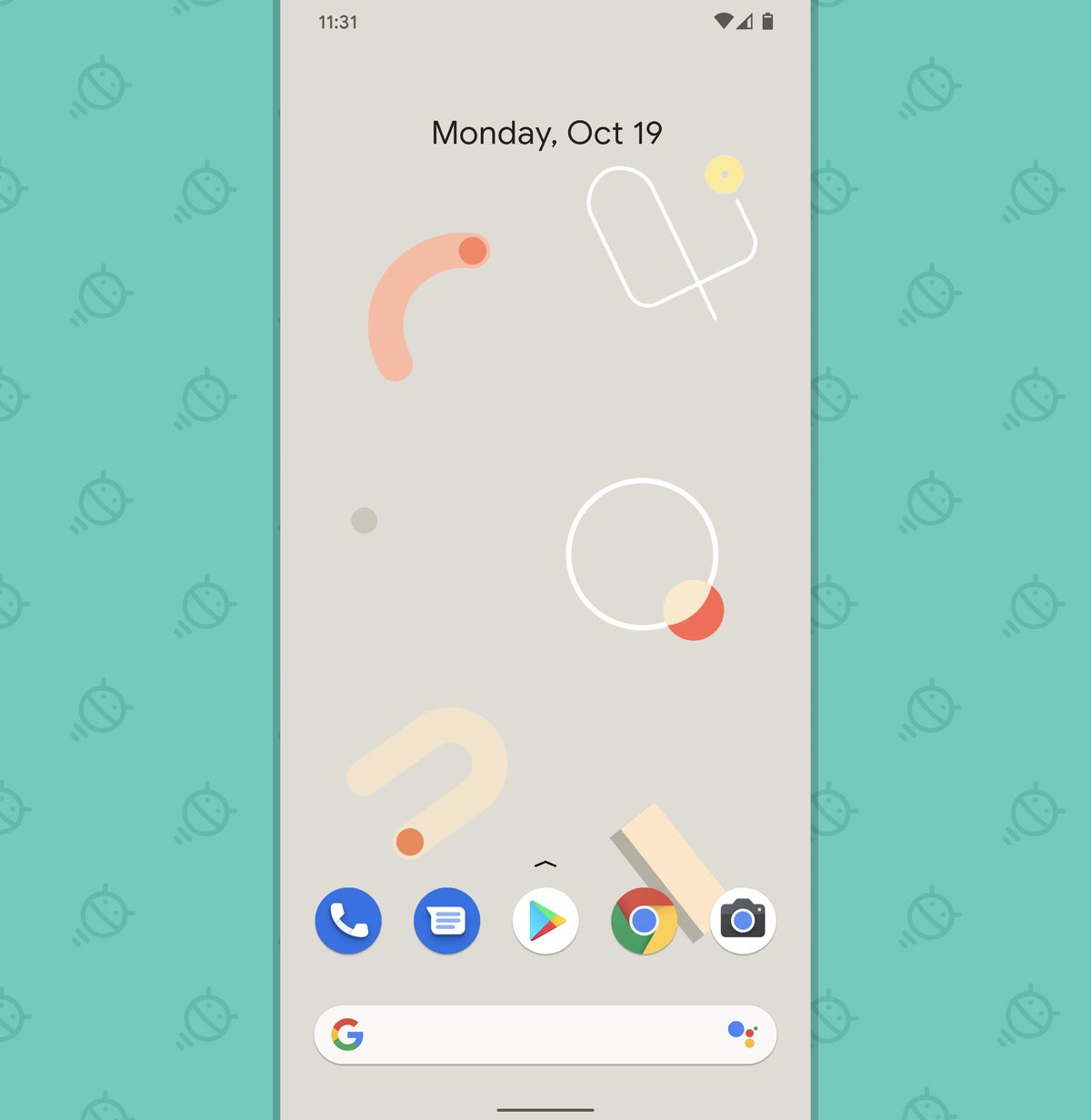 JR
JR No one can get to any of your stuff without first signing back in as you (and putting in your preferred method of authentication), and nothing done in that environment ever has any impact on your standard smartphone setup. It’s a pretty powerful form of privacy protection, wouldn’t ya say?
It isn’t, unfortunately, available for the Samsung owners among us, as Samsung has for no apparent reason opted to remove this standard operating system element from its software — but for everyone else, follow these three quick steps:
- Open up the System section of your phone’s settings.
- Tap “Advanced” followed by “Multiple users.”
- On the screen that comes up, make sure the toggle at the top is set into the on position.
And then, whenever you want to tap into your shiny new Guest Mode option, swipe down twice from the top of your screen to open your Quick Settings, tap your user profile picture (which is probably just a generic person icon in the lower-right corner of the panel), and then tap the “Add guest” option on the screen that comes up.
When you’re ready to exit out of Guest Mode and get back to normal, just open up the Quick Settings panel again, tap that user profile picture again, and select “Remove guest” from the menu that comes up. That’ll erase and reset everything that was done in that temporary profile and take you back to your own standard environment (once you’ve put in your PIN, pattern, or passcode or used your preferred appendage to prove that you’re actually you).
Hidden Android feature #7: Do Not Disturb rules
You aren’t still manually silencing your phone at night or when you’re in meetings, are you? Android’s got a native way to do that for you automatically — if you know where it is and remember to set it up.
Dig around in the Sound section of your system settings (or the Notifications section, on Samsung devices). See the line that says “Do Not Disturb”? Tap it — the actual line that says “Do Not Disturb” and not the toggle next to it, if there is one — and then look for the “Schedules” option (or for “Turn on as scheduled,” with Samsung).
There, you can activate and create all sorts of custom automatic rules for how your phone should behave during different times and conditions. Be sure to look for the plus sign or the “Add more” option to explore the various possibilities. With Pixel phones, for instance, in addition to the basic time-based rules, you can create rules that turn Do Not Disturb on automatically when you’re driving or even when specific types of calendar events are active.
Set ’em up, activate ’em as needed, and then rest easy knowing your friendly mobile companion’s always got your back.
Hidden Android feature #8: App pausing
Maybe you don’t want to silence your entire phone but just need a break from a specific app’s interruptions — a certain messaging service, perhaps, or maybe even your email. Well, Android has a little-known system that can let you pause any specific app on demand and silence it and only it until further notice.
This one’s only available in Google’s own version of Android, so if you’ve got a Pixel phone or Android One device, press and hold your finger onto any app’s icon on your home screen or in your app drawer and look for the hourglass icon and/or the “Pause app” option.
 JR
JR Tap that thing — tap it with abandon, garsh dern it! — and you’ll see the app’s icon change into a grayed-out, monochrome color. The app will then stay completely quiet until you tap it again to unpause it.
 JR
JR Ahh…the sound of silence.
Hidden Android feature #9: Focus Mode
You can take the app pausing concept even further with Android’s built-in Focus Mode — something that is available on most devices running reasonably current Android versions, regardless of who made ’em or how much meddling said company did with the software.
To check it out, look for a Digital Wellbeing section in your phone’s system settings, then look for a “Focus Mode” option within that area. The specific implementation will vary from one device-maker to the next, but in one way or another, you’ll be able to create a list of apps that you occasionally want to silence — and then optionally set a recurring schedule for when those apps, specifically, will be forced to shut their virtual yaps and stop notifying you.
 JR
JR You can also just opt to activate Focus Mode on demand when you want it — which essentially turns it into a universally available multi-app version of the App Pausing concept.
To activate Focus Mode manually, look for the Focus Mode tile within your Quick Settings panel — and if you don’t see it there, tap the pencil-shaped icon in the lower-left corner (or the three-dot icon in the upper-right corner and then select “Button order,” with Samsung) to edit the panel and add it into the mix.
Hidden Android feature #10: Notification snoozing
Man, I love snoozing. And not just the under-the-desk siesta variety, either (though a hearty kudos if you’re actually able to manage that).
Nope — I’m a huge fan of Android’s built-in ability to snooze your notifications and have ’em come back to demand your attention later in the day, just like you can with emails in Gmail. The system isn’t as fully featured and versatile as I’d like, but it’s still pretty useful.
So the next time you see a notification that you don’t want to deal with right away but also don’t want to leave lingering in your notification panel to be forgotten, do this: Swipe the notification ever so slightly to the left or to the right — not far enough to dismiss it but just enough to reveal a couple of carefully tucked away icons at its edges.
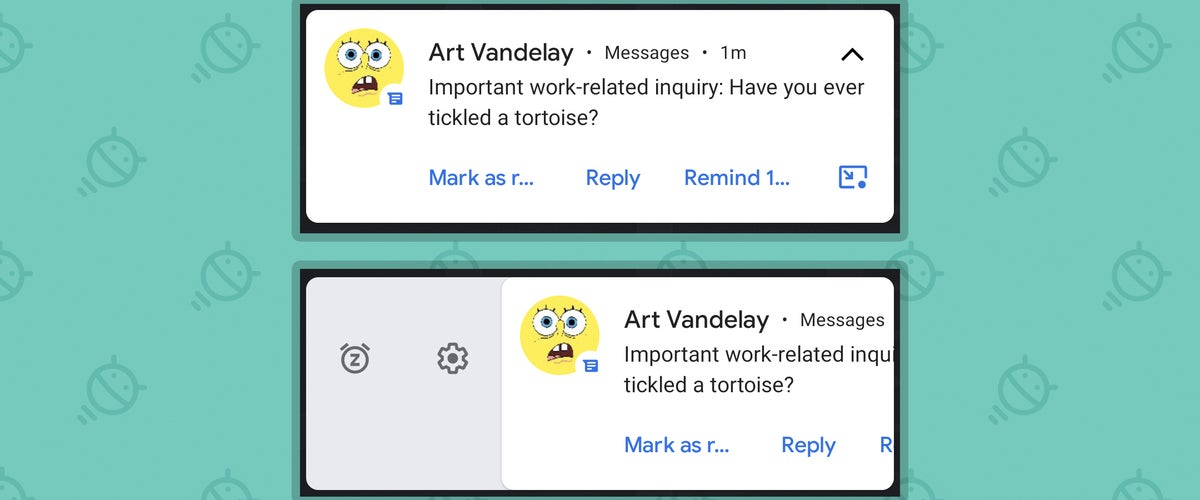 JR
JR See ’em? Tap the snooze icon — an alarm clock with a “Z” inside it in Google’s own version of Android or a bell in Samsung’s version of the software — and you’ll be able to send the notification away and have it return anew in 15 minutes, half an hour, one hour, or two hours.
In Google’s version of Android, all notification snoozing gets set to one hour by default. But you can tap the little down-facing arrow in the snoozing confirmation to see the full set of options and change it to whatever amount of time you want.
 JR
JR As an added bonus, you can then tell everyone you know that snoozing is an important part of your productivity strategy. And if they look at you like you’re crazy, well, by golly, you can just cackle knowingly as you gallop away with glee.
Want even more Googley knowledge (with or without gleeful galloping)? Sign up for my weekly newsletter to get next-level tips and insight delivered directly to your inbox.




